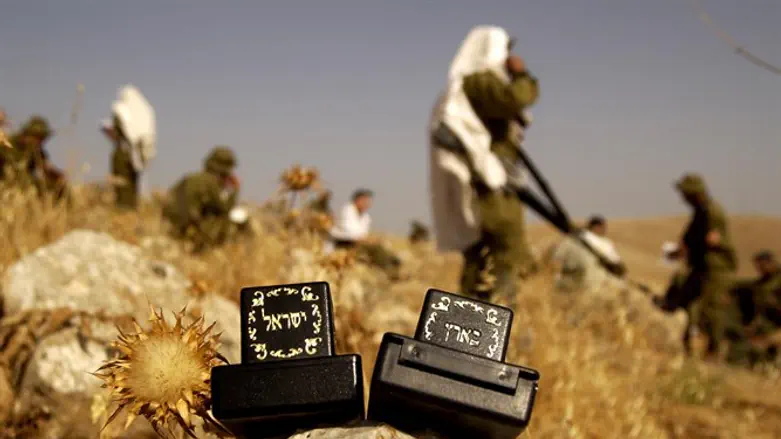
The Ba’al Shem Tov, whose yahrtzeit is on Shavuot, said that one of the most important things that we should learn from him is that despite all the lofty spiritual acquisitions that he had merited, he still served G-d with simple faith. Once, he sat his young grandson, the Degel Machaneh Efraim, on his knees and said to him, “Believe me, there is one person in the world who hears Torah – not from the mouth of an angel or a saraf, but from the mouth of the Holy One, Blessed Be He and His Shechinah.” (The Ba’al Shem Tov was referring to himself). “And at every moment, he fears that he may fall into the great abyss.”
How would the holy Ba’al Shem Tov, who heard Torah from the mouth of the Holy One Blessed Be He and His Shechinah, fall into the abyss? The answer is that if he would have felt even the slightest hint of self-importance from his lofty spiritual acquisitions, he would have immediately crashed into the deepest depths. But the Ba’al Shem Tov did not serve G-d with his spiritual acquisitions. Instead, he relied on his simple faith.
Once, after the Ba’al Shem Tov’s passing, his students sat together and told stories of the miracles that he had performed. His son, Rabbi Hersheleh, was also present. As the hours passed, Rabbi Hersheleh put his head on the table and fell asleep. And he dreamt. In his dream, his father came to him and said, “Why are they telling miracle stories about me? It doesn’t help them and it doesn’t help me!” What should they tell instead? There are a number of versions:
One version is that the Ba’al Shem Tov said that they should tell stories of his fear of Heaven. The Mitler Rebbe said that although we think of the Ba’al Shem Tov as excelling in the trait of love of G-d and of Israel, the trait in which he excelled more than anyone else was his fear of Heaven. It is known that if a cup of water was on the other end of the room in which the Ba’al Shem Tov was present, the water would tremble in the cup from the fear that the Ba’al Shem Tov exuded. Once, the Ba’al Shem Tov saw a lion approaching him. For a moment, he felt fear. Immediately he said to himself, “What is a lion? In Hebrew, it is aryeh, a permutation of yir’ah, fear.” He channeled his thoughts to fear of Heaven and paid no attention to the lion. Later, he saw the lion at the side of the path, split into two. When G-d puts a person in a situation in which he is frightened by worldly menaces, he must raise that fear to fear of Heaven, alone. The Ba’al Shem Tov told his son that stories of his fear of Heaven would be beneficial for the students and good for him, as well.
Another version says that the Ba’al Shem Tov said, “Why are you telling miracle stories about me? Tell about my self-sacrifice, that for every little aspect of Judaism or to help a fellow Jew, I would break myself into bits. I would throw myself from a high mountain and shatter into tiny splinters for any mitzvah – large or small. Tell stories about that, which was the main thrust of my work in this world, and it will be helpful to you and also to me.”
The Ba’al Shem Tov said that when we hold a small part of an object, we hold its entire essence. Every mitzvah is an immutable object, every Jew is an immutable object and every small part of him is the essence in its entirety. The Noam Elimelech once dreamt that he saw the Ba’al Shem Tov standing on a high mountain. Suddenly, he threw himself off the mountain and shattered into thousands of splinters. But every splinter was a miniature Ba’al Shem Tov – similar to Mount Sinai stones, on which the same image of a bush is engraved on every side of every splinter of the stones. The Ba’al Shem Tov shattered into 600,000 miniature Ba’al Shem Tovs, so that a splinter of himself and his simple faith would enter the heart of every Jew.
When the Ba’al Shem Tov threw himself off the mountain into the abyss, he was not relying on his lofty spiritual acquisitions. Instead, it was a leap of his simple faith, his intention of sacrificing himself for G-d, alone.
In his previous incarnation, the Ba’al Shem Tov had been a hidden tzaddik in Tzfat, who refused to reveal to Elijah the Prophet what mitzvah he had fulfilled on his bar-mitzvah, because he had done it for G-d, alone. This evoked a great response in Heaven and on earth. Doing a mitzvah for G-d alone is a novel approach of the Ba’al Shem Tov. It stems from simple faith and self-sacrifice in the uppermost realms of the soul.
In order to save a fellow Jew, the Ba’al Shem Tov was willing to take a leap of his simple faith – with the knowledge that even if he shattered into thousands of pieces, each one of those splinters would instill his simple faith into the Jewish heart that he wished to save and hundreds of thousands of precious Jewish souls.
On this holiday of Shavuot, may we all merit to adopt the Ba’al Shem Tov’s fear of Heaven and his simple leap of faith - knowing that even if we shatter, those splinters will infuse reality with miniature models of our simple faith in G-d.